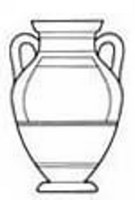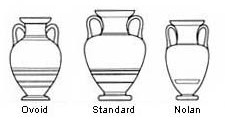Amphora

The amphora (pl. amphorae; from Greek amphi - on both sides, phero - carry) is a two-handled pot with a neck that is considerably narrower than the body. It was used for the storage of liquids and solids such as grain. Undecorated 'coarse' amphorae, with their lower part tapering to a point, were the standard transport containers in the Mediterranean. They are frequently depicted in symposium scenes. Panathenaic prize amphorae are perhaps the closest in shape, but the majority of painted amphorae are grouped into two main types, the one-piece belly-amphorae, and neck-amphorae, which have a clearly-marked neck.

The broad body, narrow neck and foot of Panathenaic amphorae gives a shape reminiscent of transport amphorae. They served as prizes in the Panathenaic Games, containing oil for victors. The Games seem to have been established in Athens in the 560s, and the earliest examples of the shape can be dated to around the same time. Panathenaic amphorae are useful for dating, since they continue to be produced well after the fourth century, becoming more elongated and elaborate. From the fourth century, the name of the archon for the year is inscribed, permitting an unusually precise means of fixing chronology. Panathenaic amphorae are only decorated in the black-figure technique. Athena always appears on one side, with the inscription "ton Athenethen athlon" - a prize from Athens. The event for which the vase was a prize is depicted on the other side. Amphorae 'of Panathenaic shape' refer to vases of this shape that are decorated in different ways, such as those in red-figure. Smaller versions also occur, perhaps as souvenirs.

Type A : This shape appears about 550 B.C. and lasts to about 450 B.C. The belly is less tense than that of the Type B amphora. The strap handles have flanges and decorated edges - usually an ivy tendril. The foot is in two degrees, the lower with a convex profile and the upper with a vertical edge. There is a fillet between the foot and the base of the body.

Type B : The most typically occurring form is termed Type B, characterised by the combination of round handles, the mouth's straight lip, and the convex profile of the one-piece foot. The shape is old, dating back to the seventh century, and continuing to be produced until the mid-fifth century. The decoration was confined to the two panels, one on the front and one on the reverse of the vase. Above these panels appears a floral chain. Above the foot is a reserved frieze which contains a band of rays. It lasts to the third quarter of the fifth century B.C.

Type C : A variation of the neck-less amphora, characterized by a continuous curve from lip to foot. The shape is similar to Type B , but with a convex (rolled) lip, and either a torus or an inverted echinus foot. This form is especially popular in the third quarter of the sixth century with the black-figure painter known as the Affecter, who also paints neck amphorae. The shape continues in red-figure pottery from about 520 to 450 B.C.

The neck-amphora is identifiable by its clearly defined neck. It has a small ovoid body and looped handles reaching from the shoulder to the neck. This amphora is so-named in modern times because of its offset neck, as opposed to the continuous curve of the belly, or one-piece amphora. It is one of the new leading shapes that comes to dominate the Protogeometric period. In Athenian black-figure, examples can be ovoid (notably the so-called Tyrrhenian amphorae, which seem to have been made for an Etruscan market), but the standard type has a more obvious 'shoulder', perhaps inspired at some stage by East Greek shapes. Another distinct type is the strap-handled Nikosthenic amphorae. These imitate a shape found in Etruscan bucchero, and the find-spots suggest that an Etruscan market was intended. Among the various types found in red-figure, distinctive are the small Nolan amphorae, identifiable by their high necks, and named after Nola where many examples were found






